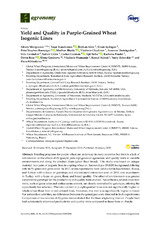Yield and Quality in Purple-Grained Wheat Isogenic Lines
Autor
Morgounov, Alexey
Karaduman, Yaşar
Akin, Beyhan
Aydogan, Sinan
Stephen Baenziger, Peter
Bhatta, Madhav
Chudinov, Vladimir
Dreisigacker, Susanne
Govindan, Velu
Güler, Safure
Guzmán, Carlos
Nehe, Ajit
Poudel, Rachana
Rose, Devin
Gordeeva, Elena
Shamanin, Vladimir
Subasi, Kemal
Zelenskiy, Yuriy
Khlestkina, Elena
Editor
MDPIFecha
2020Materia
Colored wheatIsogenic lines
Phytochemicals content
Productivity
METS:
Mostrar el registro METSPREMIS:
Mostrar el registro PREMISMetadatos
Mostrar el registro completo del ítemResumen
Breeding programs for purple wheat are underway in many countries but there is a lack of information on the effects of Pp (purple pericarp) genes on agronomic and quality traits in variable environments and along the product chain (grain-flour-bread). This study was based on unique material: two pairs of isogenic lines in a spring wheat cv. Saratovskaya-29 (S29) background differing only in Pp genes and grain color. In 2017, seven experiments were conducted in Kazakhstan, Russia, and Turkey with a focus on genotype and environment interaction and, in 2018, one experiment in Turkey with a focus on grain, flour, and bread quality. The effect of environment was greater compared to genotype for the productivity and quality traits studied. Nevertheless, several important traits, such as grain color and anthocyanin content, are closely controlled by genotype, offering the opportunity for selection. Phenolic content in purple-grained lines was not significantly higher in whole wheat flour than in red-colored lines. However, this trait was significantly higher in bread. For antioxidant activities, no differences between the genotypes were detected in both experiments. Comparison of two sources of Pp genes demonstrated that the lines originating from cv. Purple Feed had substantially improved productivity and quality traits compared to those from cv. Purple.

